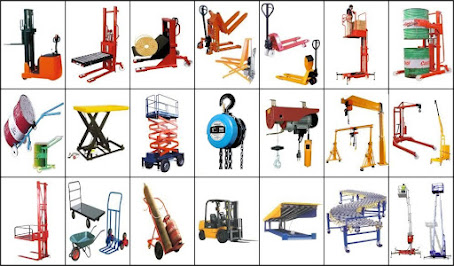Material-Handling-Equipment Tenders in Indian Tenders.
Definition of Material Handling
Material handling is an activity that involves movement of material or products within an organization from one place to another place or the flow of material or products to vehicles or from vehicles. The activities are usually confined within the boundaries of an organization. The movement of material from one organization to another is categorized as transportation work, which is not part of material handling activities.
It is not only about the movement of material. It also involves storage, protection, and control of material while it moves in different departments like a warehouse, production, and manufacturing departments. It is one of the essential tasks for organizations. A poorly handled material become waste before it can be used for production purpose or before it is sent to retail stores.
In the old times, it was mostly done manually because of the lack of technology. Because of that, the number of accidents during handling work was quite high. In present times, with the introduction of technology, almost all of the work is done using automation or semi-automation. The introduction of technology not only reduced the cases of accidents occurred but also made the work fast.
Type 1: Storage and Handling Equipment
This is the simplest type, something so basic you might not even think of it as equipment. These are shelves and racks where you store your material in between receiving it and shipping it. They are often designed to utilize vertical space so the warehouse can hold more items. Bins, drawers, stacking frames, flow racks, cantilever racks, and mezzanines are also included in this category.
Type 2: Bulk Material Handling Equipment
According to Thomas Network, this is, “the storing, transportation and control of materials in loose bulk form.” If there’s a lot of material altogether, you’re probably using bulk material handling equipment. An example would be a silo, a large cylinder that can hold stuff like grain.
Other examples include:
- Stackers and reclaimers: Large machines that are used to dump things into piles or to pick them back up again. They can be hard to visualize, so here’s an animation of one working.
- Hoppers: Picture a large metal funnel. It stores material and can release an exact quantity out the bottom.
- Grain elevators: Buildings used to store grain. They include a series of buckets on a track that automatically transports grain to the top of the building where it can be funneled into different silos.
- Bucket elevators: Similar to a grain elevator, this device features buckets that transport large amounts of material.
- Conveyor Belts: Moving belts that transport material. They can be combined into more complicated conveyor systems which are considered engineered systems. If you want a conveyor system for your business, contact DCS.
- Dump Trucks: Also a type of industrial material transport vehicle.
- Screw Conveyor: A screw-shaped device inside a tube that turns to move material.
- Rotary car dumper: A device that turns a rail car to dump out its contents.
Type 3: Industrial Trucks
These are vehicles or equipment that move materials. Sometimes workers run them, and sometimes they are automatic. Automated Guided Vehicles (AGVs) fall under both engineered systems and industrial trucks.
Other examples are:
- Hand trucks: These are also called dollies. They are simple, L-shaped devices that let you carry material at a tilt.

- Side-loaders: These are used to load materials in narrow aisles where other trucks may be too wide.
- Pallet trucks: Hand-operated or electric devices that slide into pallets to move them.
- Walkie stackers: Thomas Network explains that these “transport and lift pallets like a forklift, though they don’t include a place for the operator to ride in. They come in both powered or manual versions.”
- Order pickers: These vehicles lift a worker off the ground so they can grab high packages.
- Platform trucks: Like a dolly but with a wider platform.
- Forklifts: Operational vehicles used to lift and transport heavy items.
Type 4: Engineered Systems
This type of material handling equipment involves more complicated systems with multiple components, usually warehouse automation.
Examples would be AGVs, conveyor belt or robotic delivery systems (complicated systems that come in different shapes and sizes), or Automated Storage and Retrieval System (AS/RS), which are automated systems often incorporating AGVs which make warehouses more efficient—basically anything that moves materials around the warehouse so workers don’t have to.
This category of equipment is the most complicated and expensive, often incorporating elements from the other categories into wider more expansive systems. These systems require a lot of time and research before making an investment.
- PROPERTIES OF THE MATERIAL. ...
- LAYOUT AND CHARACTERISTICS OF THE BUILDING. ...
- PRODUCTION FLOW. ...
- COST CONSIDERATIONS. ...
- NATURE OF OPERATIONS. ...
- ENGINEERING FACTORS. ...
- EQUIPMENT RELIABILITY.
GeM Services...
- GET YOUR BUSINESSESS REGISTER UNDER GeM
- TOTAL ACCOUNT MANAGEMENT
- TENDERING SERVIC
Click on any Material-Handling-Equipment Tenders to view BOQ, NIT and Tender Documents. Get GeM Registration and Bidding Support, Vendor Registration for Material-Handling-Equipment Tenders.
Get in touch with us:
Call on: +91-92760 83333
Whatsapp on: +91-92743 15555
Email: sales@thetenders.in
visit us: https://www.thetenders.com/
#materialhandling #GovernmenteMarketplace #worktenders #GovernmenteMarketplace #latesttenders #material #materialhandlingequipmen#thetendersequipment #handling #completetenderingsolutions #rawmaterial #machinery #materialtender #handlinmgequipmenttenders #TenderInformation #tender #thetenders
For More Information visit on :
AHMEDABAD CORPORATE OFFICE
201-202, Shriji House, Nr.MJ Library,Opp-Gujarat Bhavan, Ellisbridge,,Ahmedabad - 380006. Gujarat.
Mobile : 092760 83333, 092743 15555
Email : sales@thetenders.in / ceo@thetenders.in





No comments:
Post a Comment
Note: only a member of this blog may post a comment.